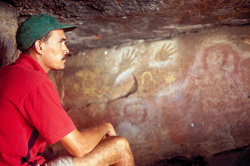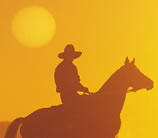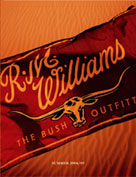ADVENTURE
 Mysterious art of the Kimberley
Mysterious art of the Kimberley
John Bradshaw, whose great-uncle Joseph was the first European to sight the now world-famous Bradshaw rock art galleries in 1891, journeys back to his family’s dreamtime in a remote region of the Kimberley.
Story and photos Adrian Parker
Western Australia’s Kimberley Plateau is one of the most remote, inaccessible and inhospitable parts of the country. It is approximately 320,000 square kilometres in area, with a population of fewer than 30,000 people and daily temperatures that regularly exceed 45 degrees Celsius. Hidden deep within this region’s rocky chasms and valleys lie overhangs and stone shelters containing vast galleries of ancient Aboriginal rock paintings.
 In 1891, pioneer and grazier Joseph Bradshaw led an expedition to assess the
pastoral viability of a million-acre crown lease, in the vicinity of the
Prince Regent River.
In 1891, pioneer and grazier Joseph Bradshaw led an expedition to assess the
pastoral viability of a million-acre crown lease, in the vicinity of the
Prince Regent River.
The party departed from Wyndham in early March, and after travelling for
almost six weeks, encountered rugged and impassable terrain. In an effort
to peruse the country before them, Joseph and his brother Fred sought high
ground. There they made an amazing discovery. In his expedition journal,
Joseph scrawled, “Further on there was a great pile of immense rocks on the
west side of the river. In the secluded chasms of these rocks were numerous
aboriginal [sic] paintings which appeared to be of great antiquity, and I
do not attribute them to the present representations of the Black [sic] race”.
Numerous expeditions have searched the Prince Regent River region to try to locate the original ‘Bradshaw’ paintings. But, until recently, the galleries remained lost because Joseph’s journal unwittingly encouraged exploration in the wrong area. His navigational misjudgements of 1891 had his party following Roe River while believing it was Prince Regent River. The consequent mystery surrounding the location of the Bradshaw galleries gave them a reputation among rock art enthusiasts on par with the legendary Lasseter’s Reef.
In 1997,
Joseph’s great-nephew, John Bradshaw, told me of his ancestor’s discovery.
He mentioned that he had helped with the rediscovery of the galleries
(see accompanying story). Last year, we decided to mount our own expedition
to the original Bradshaw art sites in the upper section of the Prince Regent
Nature Reserve on Worora traditional land. The 635,000-hectare reserve
contains more than half of the bird and mammal species found in the Kimberley,
some
500 species of plants, and is managed by WA Conservation and Land Management
(CALM). ![]()
Full story OUTBACK Issue 36 Aug/Sept 2004


